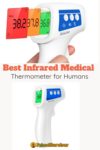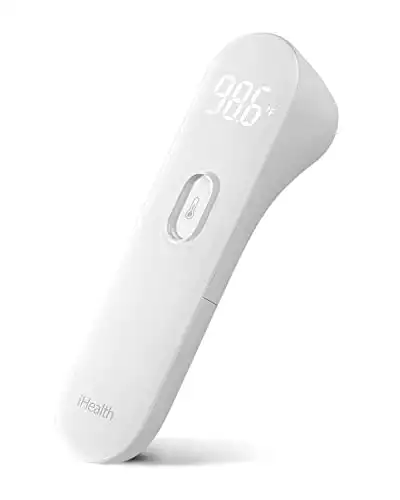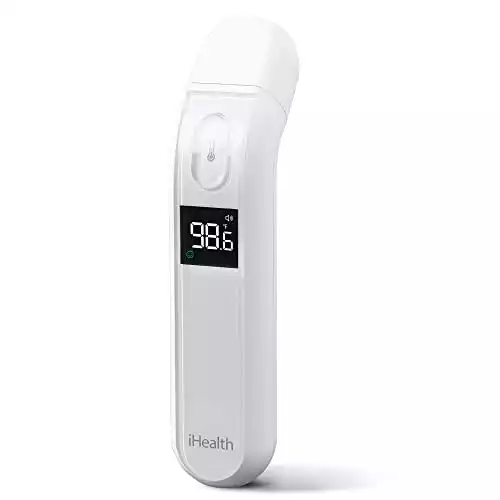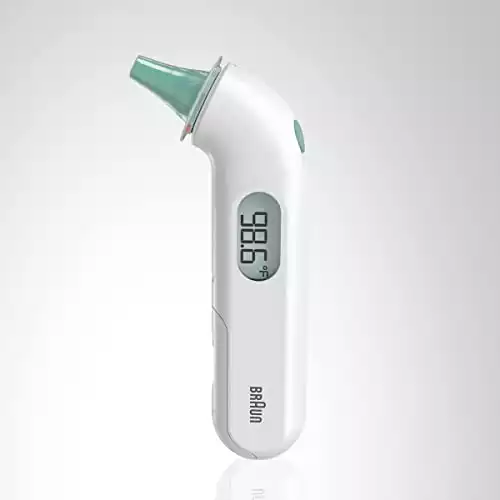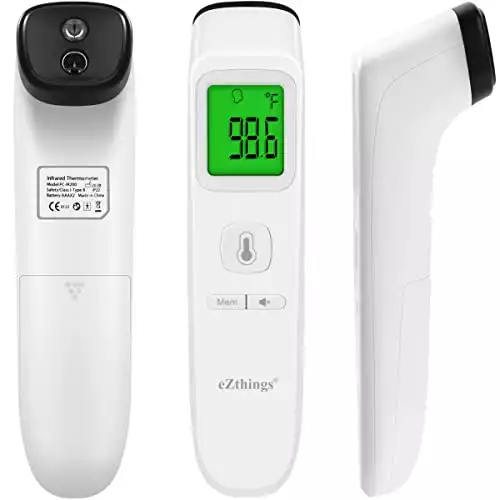Infrared thermometers are the fastest and easiest method for detecting fever in humans.
Many can even be used from a distance, so you don’t have to worry about cleaning them, disease transmission, or waking your child in the middle of the night.
List of FDA-Approved Infrared Thermometers
On their website, you can find a list of FDA thermometers that meet the 510(k) standards.
Unfortunately, using this list is very confusing because the marketing name of the thermometer isn’t always the same as the one listed in the FDA database.
For example, the “Anthansia Store” on Amazon sells a very popular IR forehead thermometer. If you type “Anthansia” into the FDA database, you won’t get any results. However, if you dig very deep into the FDA list, you’ll discover that the Anthansia thermometer is the same one made by Shenzhen Changkun Technology. The manufacturer allows their product to be sold under different brand names.
I did a lot of digging to find the best infrared medical thermometers which are FDA-approved. Here is the list. I hope you find it helpful.
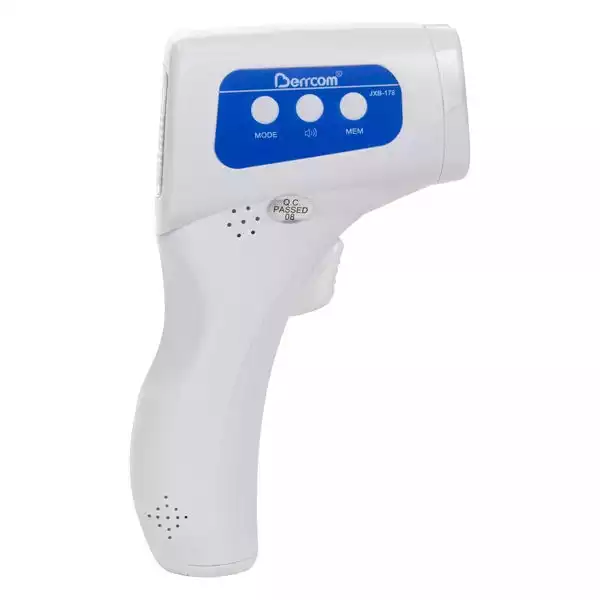 Berrcom Non Contact Infrared Forehead Thermometer
Berrcom Non Contact Infrared Forehead Thermometer
Simple to use, robust, and very accurate, this thermometer will protect your entire household.
Table Of Contents
Best FDA-Approved Infrared Thermometers for Humans
Berrcom JXB-190 Infrared Thermometer
FDA 510(k) Approval Number: K130231
Here’s an excellent IR thermometer that is very easy to use while still feature-rich. The shape of the gun makes it easy to hold correctly, so you get it at the right angle. The LCD screen changes color based on whether there is a fever. There is also a fever alarm that goes off, but you can turn it to silent mode if you don’t want to hear the beeping.
It can take skin readings, objects (like baby milk bottles), or the room. It’s also very affordable and durable, although it has a smaller memory than the ThemoDetect.
Features:
- 30-second auto power off
- Saves up to 32 readings
- Uses 2x AA batteries
- Fever alarm
- Sound or silent mode
- LCD turns green, orange, or red
- For skin, objects, or room temperatures
iHealth Thermopile Infrared Vibration Thermometer
FDA 510(k) Approval Number: K200531
The vibrating infrared thermometer by Andon (and sold by iHealth) doesn’t have many features. You can’t save readings, and there aren’t any color indications on the LCD monitor. However, it does have one very cool feature: a distance sensor.
If the thermometer is held too far away, it won’t register a reading, which helps prevent inaccurate readings. Some people also like that the thermometer vibrates instead of making a beeping sound when it is done.
Features:
- 10-second auto shut off
- Vibrates when done
- Distance sensor
- Saves up to 32 readings
- Uses 2x AAA batteries
Braun NTF300 Infrared Forehead Thermometer
FDA 510(k) Approval Number: K992468
Braun makes a few FDA-approved thermometers, including this infrared forehead thermometer. The shape is a bit weird, so you must practice to ensure you are holding the thermometer lens straight against the forehead.
Luckily, the thermometer has a “positioning sensor,” which alerts you if you are holding it incorrectly. This makes it one of the best FDA IR thermometers. The only real downside is that it won’t save readings.
Features:
- Positioning sensor
- 60-second auto power off
- Uses 2x AA batteries
- Sound or silent mode
- LCD turns green, orange, or red
Iproven Infrared Forehead Thermometer
The infrared thermometer by Iproven is one of the cheapest options. Yet, it is still very reliable and has some cool features. The LCD screen turns green for normal temperatures, orange for slight fevers, and red for high fevers. You can also change the mode to measure the temperature of objects/surfaces.
The thermometer beeps when done, but you can turn off the beeps by holding the mode button down. I also like the 30-second auto power shutoff feature.
Features:
- 30-second auto power off
- Saves up to 99 readings
- Uses 2x AAA batteries
- Sound or silent mode
- LCD turns green, orange, or red
- For skin or objects
iHealth Infrared Forehead Thermometer
FDA 510(k) Approval Number: K200710
Here’s a very affordable infrared medical thermometer for home use also sold iHealth. It has a color-coded indicator so you can see immediately if there is a fever. The thermometer beeps when it’s done taking a temperature reading, but you can also put it in silent mode.
The 8-second automatic power off helps save battery life but is too short to use in group/work settings. Unfortunately, you can’t save readings. The shape of the thermometer does take a bit of getting used to; it’s easy to hold it at the wrong angle and get inaccurate results.
Features:
- 8-second auto power off
- Uses 2x AAA batteries
- Sound or silent mode
- LCD turns green, orange, or red
Braun ThermoScan 3 Infrared Ear Thermometer
FDA 510(k) Approval Number: K161933
If you want an infrared ear thermometer, the ThermoScan 3 is approved by the FDA. It’s a bit pricier than other options but does give speedy readings and is accurate (if you keep it clean and use it correctly!).
The thermometer gives one beep for a normal temperature, two beeps for a fever, and four beeps for a high fever. Unfortunately, you can’t turn off the beeps. Like with many other ear IR thermometers, there is a learning curve, so don’t be surprised if you get varying readings when first using it.
Features:
- 60-second auto power off
- Uses 2x CR2032 batteries
- Beep fever indicator
- Comes with 21 covers
eZthings Forehead Infrared Thermometer
FDA 510(k) Approval Number: K181215
This infrared thermometer is made by the Chinese manufacturing company Shenzhen Finicare but sold under eZthings. You can also find it sold under other generic names too.
While it is a cheap IR thermometer, it is FDA approved and has nice features like being able to store readings and a color-coded display. Unfortunately, there are a lot of reviewers who say they got fake products instead of real FDA-approved thermometers. So, buy at your own risk.
Features:
- 10-second auto power off
- Saves up to 35 readings
- Uses 2x AAA batteries
- Sound or silent mode
- LCD turns green, yellow, or red
- For skin or objects
What Are Infrared Thermometers?
Infrared thermometers have a lens that detects infrared energy on a surface. The thermometer then converts this information into a temperature.
They have long been used in industry to measure temperatures of moving machinery but are now becoming very popular as a way to quickly detect fevers in humans without having to make close contact.1, 2,
Other Names for Infrared Thermometers
- Forehead thermometer
- Non-contact thermometers
- Laser thermometers
- Temperature guns
- Temporal artery thermometers
- Tympanic thermometers
How Infrared Thermometers Work
All things on earth, including humans, emit a type of electromagnetic radiation called infrared radiation (also called infrared light).3 It is impossible to see infrared light with our eyes, but it can be detected as heat.
When you hold the infrared thermometer up to a surface, the thermometer’s optical lens detects infrared light and focuses it onto a sensor. The thermometer then converts the information into a temperature reading.
Infrared Thermometers vs. Other Thermometers
Mercury Thermometer
Traditional or “normal” thermometers contain a metal (usually mercury) which is liquid at everyday temperatures. The liquid expands as it gets warmer.
Pros:
- Cheap
- Easy to use
- Accurate and reliable
Cons:
Digital Thermometers
The principle behind how digital thermometers work is that electricity flows through metal differently as the metal changes temperature. As the metal gets warmer, its atoms will vibrate faster and create more resistance, making electricity harder to pass through the metal.
A sensor in the digital thermometer detects changes in resistance. A small computer in the thermometer then converts this information into a temperature reading.
Digital thermometers can give readings very quickly, but their readouts are prone to inaccuracies. For example, the digital thermometer might not provide accurate results if you’ve eaten or drank something within 15 minutes. Digital thermometers also don’t account for ambient room temperature. You may need to let the thermometer adjust to room temperature for 15 minutes before taking a reading.
Pros:
- Quick and easy
- Many types available
- Generally cheap and affordable
Cons:
- Prone to inaccuracies
Types of Infrared Thermometers
Forehead (Temporal)
These infrared thermometers are held on or near the forehead. They can also be used on other body parts, such as the stomach. However, the forehead is usually recommended because the temporal artery is located there. It has constant blood flow, and because the skin on the forehead is thin, it’s easier to get a good reading.8
The main benefit of temporal infrared thermometers is that they are non-invasive. You can use them on sleeping patients. Contactless thermometers don’t have to get too close to the patient, which is essential for reducing disease transmission. They are also easy to clean and don’t require any covering.
Ear (Tympanic)
Many people don’t realize that ear thermometers, aka tympanic thermometers, are a type of infrared thermometer. The difference is that ear thermometers detect core body temperature, whereas temporal thermometers detect surface temperature.
Because surface temperatures are influenced by the surroundings, core temperature readings are thought to be more accurate. However, because of issues like the shape of the ear canal and wax buildup, ear thermometers aren’t necessarily more accurate than forehead thermometers (more on this later in the accuracy section).
Ear infrared thermometers are invasive, require contact with the patient, and have coverings that should be changed between patients. Because of this, contactless temporal thermometers are becoming more popular, especially when taking the temperature of large groups of people.
Industrial Infrared Thermometers
Infrared thermometers are used in many industries to detect the temperatures of machinery, conveyor belts, and even food. Industrial infrared thermometers should not be used on humans. The main reason has to do with emissivity.
Emissivity is a measurement from 0 to 1 of how an object emits infrared energy. Human skin has a measurement of 0.98. Medical IR thermometers will be preset to this amount. By contrast, industrial IR thermometers will have multiple emissivity settings.
While you could adjust the emissivity setting of an industrial infrared thermometer to match human skin, using them on humans is still not recommended. Industrial IR thermometers have lasers that the user aims at a surface. These lasers can cause damage if they accidentally get into someone’s eyes.9
Accuracy of Infrared Thermometers
There is a lot of controversy about whether infrared thermometers are accurate for detecting fever or not. While digital rectal thermometers are still considered the gold standard, numerous studies show that infrared thermometers are accurate but with one caveat: they must be used correctly.10, 11
Unfortunately, there are a lot of factors that can cause infrared thermometers to give inaccurate results.
Ear infrared thermometers may give inaccurate results if:
- Thermometer isn’t deep enough in the ear
- Ear canal isn’t straight
- Wax buildup in ear
- Covering is dirty
Forehead infrared thermometers may give inaccurate results if:
- Patient is sweaty
- Skin is obstructed, such as by hair, scarves, or even skin creams
- Scarring on the skin
- Thermometer is positioned incorrectly
- Sensor gets dirty
- Patient’s forehead is in direct sunlight
- High humidity in the room
How to Get Accurate Results with Infrared Thermometers
You must read the manufacturer’s instructions and follow them carefully.
For example, forehead thermometers usually must be held parallel to the forehead. You may not get an accurate reading if you have it at an angle. Likewise, the reading may be inaccurate if you hold the thermometer too far away or too close to the forehead.
You often have to pull the ear outwards with infrared thermometers so the thermometer sits correctly in the ear. You must keep the ear covering clean; when the manufacturer says to replace the cover after each use, they mean it!
Many experts recommend taking three different readings with the IR thermometer and then taking the average. If unsure, you can always check the temperature with an oral thermometer.
Are Infrared Thermometers Safe?
Infrared thermometers are safe, and there is no evidence of adverse effects from them.13 Despite this, many people still mistakenly believe that infrared thermometers emit unsafe waves. Infrared thermometers do not emit energy. Instead, they detect energy.
An infrared thermometer might be dangerous only if it has a laser pointer that gets shone into the patient’s eyes. Because of this, most medical IR thermometers don’t have lasers; they are primarily found on industrial IR thermometers.
What Does FDA-Approved Mean for Thermometers?
FDA approval for thermometers is confusing because the FDA doesn’t test products. Instead, they review products. If the product is shown to be “safe and effective” as thermometers that are already marketed for the same use, it will receive 510(k) clearance by the FDA.14, 15, 16
Regulations for FDA-Approved Infrared Thermometers
To get the 510(k) clearance from the FDA, a manufacturer will typically show proof that their thermometer meets testing standards. The best testing standard for infrared forehead thermometers is ASTM E 1965-98. This standard requires the thermometer to be accurate within ±0.54 °F (± 0.3 °C). Infrared ear thermometers have stricter regulations; they must be accurate within ±0.36 °F (± 0.2 °C).
Other standards can be used for infrared thermometers, such as the IEC standards and CE approved in Europe or ISO standards for medical devices internationally. Because FDA approval is expensive and only valid in the USA, many manufacturers don’t bother getting the FDA approval and instead will get one of these approvals instead.
